Zotac's Ion: The World's First mini-ITX Ion Board
by Anand Lal Shimpi on May 12, 2009 12:00 AM EST- Posted in
- GPUs
The Zotac Ion is available as a mini-ITX motherboard alone. Mini-ITX will work in ATX, micro-ATX, and mini-ITX cases.
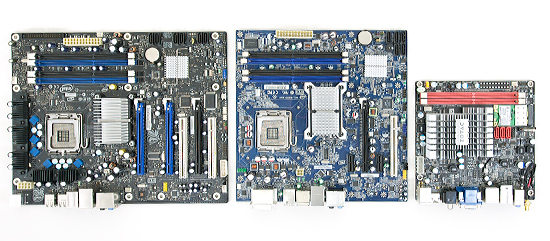
From left to right (ATX, micro-ATX and mini-ITX)
There are two versions of Zotac’s Ion, the ION-ITX-A-U and the ION-ITX-B-E. The more expensive “A” model ships with a dual-core Atom 330 processor, a mini-PCIe WiFi card and an external DC power supply. The “B” model comes with a single-core Atom 230 processor, no WiFi and requires a standard power supply. They are priced at $189 and $139, respectively, from etailers. Add another $10 for retail pricing. Update: Zotac just informed me of two additional versions coming: a C and a D version. The C version will be a single-core product with the DC power supply and the D version will be a dual-core product with no power supply.
Availability will be in limited quantities starting this week. Zotac hopes to have more widespread availability by June.
The first change compared to Intel’s desktop Atom boards is that the Zotac board is entirely passively cooled. While Zotac ships a fan in the box, it’s optional to use. Granted the heatsink on the Zotac Ion is huge, inevitably adding more cost to the board but I’d take that over a spinning fan; the Zotac Ion is completely silent.

The optional fan
Zotac gives us two DDR2 DIMM slots (4GB max total memory) instead of one on the Intel boards, and it supports up to DDR2-800 memory. While Zotac could’ve opted for DDR3 slots, DDR2 seems like a safer bet since you’re more likely to have spare DDR2 memory laying around these days (especially after you make that upgrade to Phenom II or Core i7).

Oooo, expansion
We get three SATA ports instead of two, but no PATA ports. There’s no PCI slot but you do get a mini-PCIe slot for an optional WiFi card.
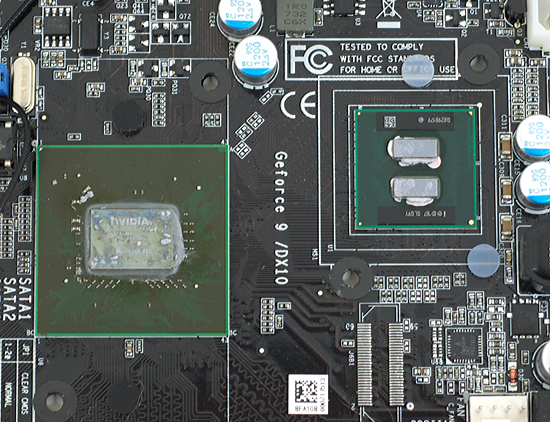
The GeForce 9300, the heart of NVIDIA's Ion platform
On the rear Zotac outfitted the world’s first mini-ITX board with every port you could possibly want. For display output you get everything that matters: VGA, DVI and HDMI. You’ve got three ways of getting audio out of the board: analog, optical or coaxial digital.
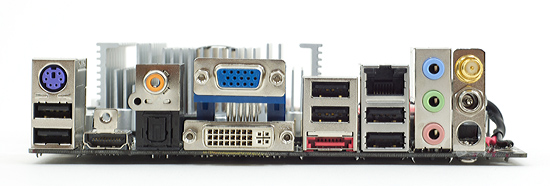
Now that's more like it
There are six, count em, six USB 2.0 ports - up from the four on the Intel boards, a single Gigabit Ethernet port (just like on the Intel D945GCLF2), eSATA and a PS2 port. I believe the only feature advantage Intel holds is that its Atom boards have two PS2 ports, one for keyboard and one for a mouse, while the Zotac board only has a keyboard port.
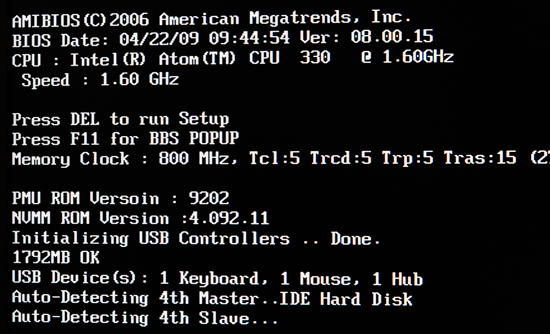
Zotac's POST screen. Spot the spelling error and embarrass Zotac for 15 points.
Assuming you have a USB mouse, Zotac wins hands down in the feature comparison and that’s without giving it extra points for having a way more capable graphics core than the D945GCLF2. I don’t think I’d change a single thing on the Zotac Ion; it’s possibly the manliest Atom motherboard on the market. *grunt*
Unique to the dual-core model I tested is an external DC power supply. The board has no ATX power supply connector on it, instead it relies on an external 90W power brick similar to what you’d get with a large notebook.
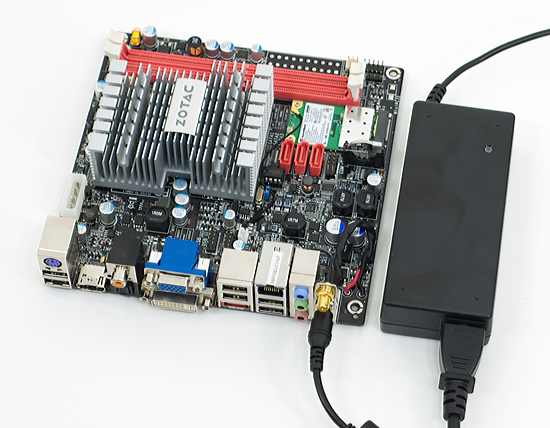
Powah
Just plug the power brick into the I/O panel of the motherboard and you’re good to go. Zotac was careful to put the DC input on the rear of the motherboard so it can still be used in any ITX case, even ones with an internal power supply.
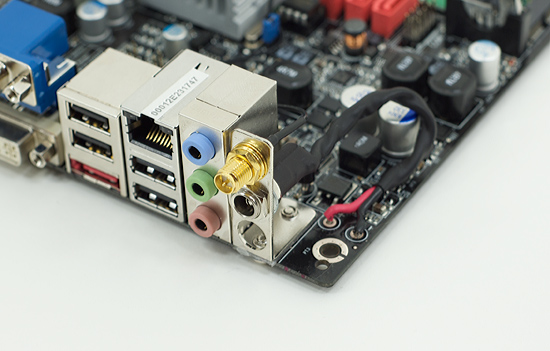
Plug the power brick into the rear panel underneath the WiFi antenna.
There’s a single 5-pin molex connector on the motherboard that can be used to power your SATA drives. Zotac ships the motherboard with a cable that provides three SATA power connectors off of the one on-board molex connector. Given that the board only has 3 SATA ports on it, the 3 power connectors should suffice. Note that they are only SATA power connectors, if you have older drives you’ll need a different cable.
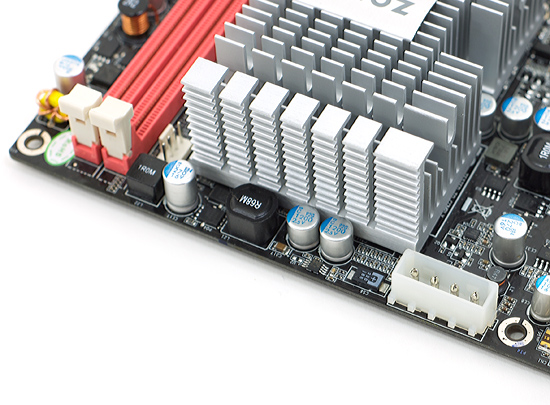
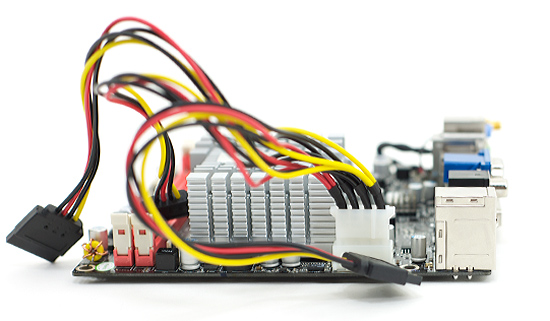
The external power supply is nice to have. It simplifies the construction of your system greatly. You can take the board and pretty much just set it anywhere you want. It’s passively cooled so you don’t need to worry about dust, just don’t put it on anything that conducts electricity.
The only issue I have with the external power supply is that it’s not as easy to replace as a standard ATX power supply. The brick is made by Delta and you might be able to find something with similar specs online, otherwise you’re left asking Zotac for another should something happen to yours.










93 Comments
View All Comments
gochichi - Tuesday, June 2, 2009 - link
The board is cool as could be. And also, the external power brick is precisely what is needed to make this thing relevant.I've always had a dream to build my old computer case, to build a computer that was unique in its size and look. I'm a pretty good wood worker, and I can cast simple aluminum shapes... you get where I'm going with this.
So this obviously is the dream motherboard for that application. Making some awesome looking little computer out maple or something.
It also hits the mark with the silent or near silent design. You add a laptop hard drive for its quiet operation and you're in business.
I am impressed, and as an enthusiast it hits the marks. The problem is that I'm more of an enthusiast in my mind than in my purchases. I snap out of the trance and realize that for the price of the motherboard you can have a complete computer w/ a case and a warranty with a 2.2ghz core-based single core Celeron which would just about trounce this little fellow. It's not quiet and it's not tiny but I'm a looser like that. I just can't do it.
Then again, I don't have a ton of extra cash. I can think of a million things I'd rather do with $400.00 than build a swanky looking (and silent) PC with this platform.
This platform is ripe for the picking. It's cheap to make, and it fills a need. We need to start seeing these out in the stores in volume. Because at the end of the day, these computers could be small enough that you don't even see them. Ubuntu is also ripe for the picking (Microsoft is fine, just too expensive for these little machines IMHO).
It is absolutely possible, to make a desirable machine out of this with 2GB of RAM and an 80+ GB hard drive for the sub $200 range. I can find some pictures of Acer's computer, but I haven't seen it at Walmart... so really, it hasn't been released yet. These products are profitable and cheap, why aren't companies making them?
Hrel - Wednesday, May 27, 2009 - link
Seems to me this article shows you wasted money, and could have easily gotten away with putting an E5300 in your HTPC, or similar, and saved what? 300 dollars. Yeah, Q9650 still costs WAY too much to be a viable option, and for most uses is overkill anyway, especially for an HTPC.piasabird - Sunday, May 24, 2009 - link
How would this compare to an Intel 1.4 Gig Celeron? I have an Intel 1.2 gig Celeron and it still runs and it runs fairly cool with a lower end power supply. This is the Celeron based on the PIII. Is the Atom processor more advanced that that?ozonarium - Tuesday, May 19, 2009 - link
Why these things do not have a video input for video recording? Or I'm missing something. Thanks.Guspaz - Sunday, May 17, 2009 - link
You'll probably get better results from CoreAVC for h.264 playback (compared to MPC-HC's DXVA codec) for at least two reasons:1) CoreAVC is far better multithreaded than libavcodec, which MPC-HC's decoder ultimately relies on. It makes 720p h.264 generally playable on an Atom 230 even without any acceleration, and the 330 should have no issues
2) CoreAVC recently added CUDA support, which includes the 9300 used in the Ion.
I also recommend combining it with Haali's Renderer (comes with Haali's Splitter) and giving it a chunk of RAM for the buffer. It will buffer uncompressed frames/audio and help smooth over any spikes in CPU usage.
mode101wpb - Thursday, May 14, 2009 - link
I have been eyeing this one up since I knew about it. I recently built the MSI Wind PC barebones nettop single core 230 Atom. It handles 720p fine if it's not streaming, albeit the processor is loaded 90%, 1080p is not possible on the 945GC.The Ion will smooth over some of the issues nicely, as well the Zotac board supports up to 4GB of ram, the MSI Wind PC nettop maxes out at 2GB, though it supports x64 there isn't enough Ram available to make good use of it. The Zotac has the same processor (230) so x64 is not an issue either. DVI is nice as is the power brick.
Newegg has two 230 mobos in stock, $149 w/o the 90w brick, and $169 with it. Not cheap, figure in $50 for 4GB of Ram, optical drive (blue ray $$$ or dvd), hdd and a case it's easily a $300-600 build for the single core 230. No pricing on the 330 yet, but I suspect it will be over $200.
I would opt for the dual core for better performance, albeit heat and energy savings will be sacrificed. Still have to wonder justification on this, the Atom has limitations and there will be a bottleneck for sure.
nubie - Thursday, May 14, 2009 - link
It's only $139 for a socket 775 version.The Celeron 420/430/440 are much more powerful than an Atom. Even if you underclock them a little.
If you need "power brick" power investigate the PicoPSU: http://www.mini-box.com/DC-DC">http://www.mini-box.com/DC-DC
I am sure if you want a proper mini PC you could build one on 775 (don't forget that there are 45nm processors and you can use a copper core heatsink, even a $10 OEM one from the older 65nm Quad cores will keep it running very cool).
I would love to see the power usage back-to-back with a PicoPSU between the "Ion" and the LGA 775 platform (please choose a low-end proc like Cel 1400/1500 or e5200, and throw in a Celeron 420-440 as well). I would expect it to be 10-15 watts more, but with much more processing power.
monomer - Thursday, May 14, 2009 - link
A few weeks ago, Anand posted an article regarding Blu-Ray playback performance issues with the Ion chipset, which was quickly taken down after Nvidia wanted time to replicate the results. Whatever happened with this? Was there some type of workaround used to fix the Blu-ray playback?strikeback03 - Thursday, May 14, 2009 - link
On page 3:"Earlier versions of PowerDVD were not well optimized for Atom, but the latest updates to PowerDVD 8 and PowerDVD 9 ensure smooth playback on even a single-core Atom/Ion system (I used an older version of PowerDVD in my short lived Ion Blu-ray Investigation which was the cause for poor performance in those tests)"
OSdeveloper - Thursday, May 14, 2009 - link
Since most people are using Windows XP, and especially since XP is more likely to be used on Atom based computers, it would be more meaningful to run benchmarks with XP rather than Vista. Other than that, it was a very interesting read. Good job Anand!